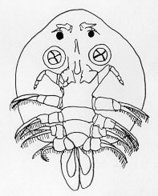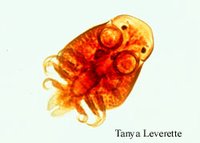
(Source: Biodiversity Institute of Ontario)
| Maxillopoda | ||
| Arthropoda | Branchiura |
| Arthropoda | Eucrustacea
└─► |
|||
| Branchiopoda | None |
Ostracoda |
|
Abbreviated Dendrogram
Crustacea
├─Phosphatocopida
└─┬─Branchiopoda
├?─Xenocarida
╘═╤═Maxillopoda
│ ├─Thecostraca
│ ├─Branchiura
│ ├─Branchiura
│ └─Copepoda
├─Ostracoda
└─Malacostraca
|
Contents
|
Taxa on This Page
This content on this page copied verbatum from Encyclopedia of Earth - Crustacea under Creative Commons Attribution Share-Alike license. It is intended at some point to add additional material on evolution, paleontology, etc MAK120517
Branchiurans are parasites once considered to be a group within the copepods, but recent phylogenetic studies have elevated the group to its own subclass. Their common name "fish lice" comes about because they attach themselves to the outside of fish.
 (Source: Biodiversity Institute of Ontario) |
Branchiurans are highly modified to suit their parasitic life style. They are dorsoventrally flattened and their carapace has been widened to cover most of their appendages. Two compound eyes make them easily distinguishable from parasitic copepods. Their mandibles have been modified into a proboscis used to suck food out of their prey. Large suckers are actually modified maxillules and are used to help 'stick' to their host. They have eight legs and a small tail that acts like a rudder when swimming. A hollow spine is used to pierce the skin of the host and access the nutrients inside. Argulus sp. can grow to 10 mm in length, but most are only 7 mm.
 (Source: Biodiversity Institute of Ontario) |
Male and females branchiurans drop off their host to look for mates. They swim (or somersault) through the water until a mate is encountered. After mating the females search for an egg-laying site where they attach their eggs in rows to rocks and other submerged objects. The free swimming larvae attach themselves in the gill chamber, mouth or on the outer surface of host fish with hooks that are modified antennae and maxillules. In 4 to 5 weeks the larvae become adults.
Branchiurans feed on the blood or body fluids of their host. They attach to their host using modified hooks and sucker, but can also detach and swim through the water when looking for mates. They have many host species including the common carp, Cyprinus carpio, and the white sucker, Catostomus commersoni. Heavy infestations of branchiurans can cause mass mortalities in fish populations. Argulus sp. are also suspected to spread viruses.
Many parasites eat blood, but branchiurans also feed on the mucous of their hosts.
From "Crustacea", Encyclopedia of Earth. Eds. Cutler J. Cleveland (Washington, D.C.: Environmental Information Coalition, National Council for Science and the Environment) 100219; revised 110529; Creative Commons Attribution Share-Alike